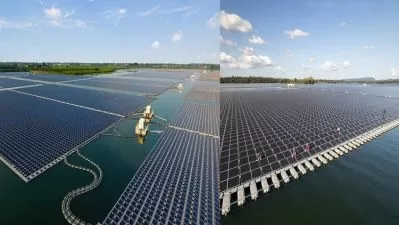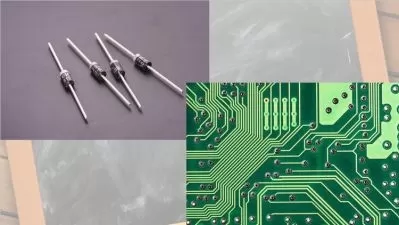A-Z Microbit: Officially accredited by Microsoft [2020]
Saral Tayal
5:21:34
Description
Absolute beginner's guide to learning coding, electronics & robotics on the Micro:bit via fun projects. Become an expert
What You'll Learn?
- Create advanced robotics and electronics projects using learnt hardware (electronics) and software (code) skills
- Write Code to integrate input and output electronics (Motors, sensors etc.)
- Understand how to wire sensors and other electronics
- Understand how to write code to read values from sensors and control electronics like motors
- Add wireless functionality to any DIY Project
Who is this for?
What You Need to Know?
More details
Description________
Have you always wanted to understand the hype behind robotics, coding, electronics, tech, but were overwhelmed by the complexity and not sure where to get started?
This course will avoid all that confusion by taking you step-by-step through understanding everything about robotics, coding and electronics.Â
Each module of this course revolves around learning key concepts via building fun projects, robots and experiments. Some of the projects we create in the course are: Sunflower robots, Wall detection cap for blind people, air piano, deuce game generator, digital hot-potato, Treasure hunt using wireless data transmission, pressure sensitive instrument, rock paper scissors generator and more!
Furthermore, each module of the course also includes concepts breakdowns, coding walk-through, challenges and assessments, assembly videos, and demos.
The course is centered around the BBCÂ Microbit Platform:Â The world's easiest and most friendly electronics and coding platform. In fact all the coding can be done on any device- computer, tablet, or phone.
All the code we write will be picture based graphical code. No confusing text based code! Graphical code is much easier to understand but the computer science principles learnt in the course are identical to what professional programmers use.
The course progression is as follows:
The course will first introduce us to what the MicroBit platform is and how to use it
Then we will learn the fundamentals of programming and computer science (coding)
We will then dive in to electronics by exploring the built in sensors and output devices of the MicroBit (simple electronics)
Only once comfortable with coding and electronics such as sensors will we start to use external electronics and learn how to wire (code+advance electronics +Â robotics)
Lastly we learn how to integrate wireless communication into our projects.(code+electronics+robotics)
Each module will build on what you learnt in the previous module and no prior knowledge will be required.
This course will make you a creator, an innovator, a leader in a increasingly digital world filled with robots. With a solid understanding of electronics, sensors, and computer science principles, you will be primed to progress to harder concepts like IOT, AI, Machine learning. Learnings from this course will be applicable to all fields from manufacturing, or military, automation, self-driving cars, smart cities etc.Â
Tools required-
No hardware & tools needs to be purchased. MicroBit has a free built in online simulator. However, it is recommended that you do purchase the following hardware to physically see how your code works for the projects we create.
Module 1, Module 2, Module 3- Just a MicroBit
Module 4- LEDs, Push Button, Servo, Distance sensor, speaker/earphones for music, moisture sensor, aligator clips + jumper cables
Module 5- Secondary MicroBit
A full list of recommended hardware + multiple purchase links (with international shipping) is available in the last document of the course
Check out my Youtube video tutorials as well!
Who this course is for:
- Students and Adults who have always wanted to code, learn electronics, or create robots but don't know where to start
- People interested in learning robotics and DIY through both hardware(electronics) and software (coding)
- People who enjoy making and DIY and want to integrate robotics and electronics in their projects and creations
- Learners can be any age group- kids to adults since robotics and coding isn't age limited
________
Have you always wanted to understand the hype behind robotics, coding, electronics, tech, but were overwhelmed by the complexity and not sure where to get started?
This course will avoid all that confusion by taking you step-by-step through understanding everything about robotics, coding and electronics.Â
Each module of this course revolves around learning key concepts via building fun projects, robots and experiments. Some of the projects we create in the course are: Sunflower robots, Wall detection cap for blind people, air piano, deuce game generator, digital hot-potato, Treasure hunt using wireless data transmission, pressure sensitive instrument, rock paper scissors generator and more!
Furthermore, each module of the course also includes concepts breakdowns, coding walk-through, challenges and assessments, assembly videos, and demos.
The course is centered around the BBCÂ Microbit Platform:Â The world's easiest and most friendly electronics and coding platform. In fact all the coding can be done on any device- computer, tablet, or phone.
All the code we write will be picture based graphical code. No confusing text based code! Graphical code is much easier to understand but the computer science principles learnt in the course are identical to what professional programmers use.
The course progression is as follows:
The course will first introduce us to what the MicroBit platform is and how to use it
Then we will learn the fundamentals of programming and computer science (coding)
We will then dive in to electronics by exploring the built in sensors and output devices of the MicroBit (simple electronics)
Only once comfortable with coding and electronics such as sensors will we start to use external electronics and learn how to wire (code+advance electronics +Â robotics)
Lastly we learn how to integrate wireless communication into our projects.(code+electronics+robotics)
Each module will build on what you learnt in the previous module and no prior knowledge will be required.
This course will make you a creator, an innovator, a leader in a increasingly digital world filled with robots. With a solid understanding of electronics, sensors, and computer science principles, you will be primed to progress to harder concepts like IOT, AI, Machine learning. Learnings from this course will be applicable to all fields from manufacturing, or military, automation, self-driving cars, smart cities etc.Â
Tools required-
No hardware & tools needs to be purchased. MicroBit has a free built in online simulator. However, it is recommended that you do purchase the following hardware to physically see how your code works for the projects we create.
Module 1, Module 2, Module 3- Just a MicroBit
Module 4- LEDs, Push Button, Servo, Distance sensor, speaker/earphones for music, moisture sensor, aligator clips + jumper cables
Module 5- Secondary MicroBit
A full list of recommended hardware + multiple purchase links (with international shipping) is available in the last document of the course
Check out my Youtube video tutorials as well!
Who this course is for:
- Students and Adults who have always wanted to code, learn electronics, or create robots but don't know where to start
- People interested in learning robotics and DIY through both hardware(electronics) and software (coding)
- People who enjoy making and DIY and want to integrate robotics and electronics in their projects and creations
- Learners can be any age group- kids to adults since robotics and coding isn't age limited
User Reviews
Rating
Saral Tayal
Instructor's Courses
Udemy
View courses Udemy- language english
- Training sessions 44
- duration 5:21:34
- English subtitles has
- Release Date 2023/08/21











